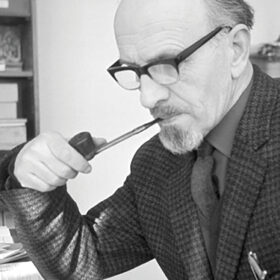framed dimensions: 100 x 125 cm
Signed lower centre
EXHIBITED:
Annual Exhibition, Royal Scottish Academy, Edinburgh, 1953, cat. 280
Prior to becoming Warden of Hospitalfield (1948-1954), Fleming and his friend and contemporary William Wilson periodically travelled throughout Scotland to paint the landscape, but it was not until Fleming’s time in Arbroath that he began to paint the coastline in earnest, developing a particular fascination with the harbour. The more time Fleming spent observing the visual environment of Arbroath and engaging with its community, the more he found to explore through his artwork. Details of the buildings are then reduced to increase the emphasis upon their underlying geometric structures. The sense of depth is also challenged, as the extreme tilting of the pier in the foreground contradicts the perspective established in the mid-ground. In addition, the lifebelt and stand, which span the height of the images further emphasise the surface and two-dimensionality of the image. This sense of two-dimensionality reduces the harbour buildings, the harbour wall, and the life-preservers to geometric patches of paint. These paintings are representative of Fleming’s process of continuously reinterpreting the landscape through form and composition, a practice which would continue to develop during and following his time at Hospitalfield.
Edited extract from Peggy Beardmore, Students of Hospitalfield | Education and Inspiration in 20th-Century Scottish Art, Sansom & Co., 2018

Ian Fleming was born in Glasgow in 1906 and studied at Glasgow School of Art during the 1920s. He began printmaking at art school, where his skill was quickly noticed, with Glasgow Art Gallery purchasing two of his prints while he was still a student. He joined the staff at Glasgow School of Art in 1931 and soon met the Edinburgh-based printmaker William Wilson through their mutual acquaintance Adam Bruce Thomson. Wilson and Fleming struck up an important friendship, sharing views on printmaking technique and subjects, their influence on each other was of mutual benefit to both their practices. During his time at Glasgow School of Art Fleming painted a portrait of the two Roberts – Colquhoun and Macbryde – who were his students at the time (alongside a young Joan Eardley). During the War, Fleming served first as a reserve policeman before joining the Pioneer Corps seeing action in France, the Low Countries and Germany. He left the Army in 1946 as an Acting Major and returned briefly to Glasgow before taking up the position of Warden at Hospitalfield, Arbroath, succeeding the artist, James Cowie. The fishing towns of Angus and Kincardineshire were to be his inspiration for many paintings of this period in which he celebrated the colour, forms and architecture of the working harbour communities. In 1954, he relocated to Aberdeen as Principal of Gray’s School of Art but continued to pursue his painting practice alongside his academic commitments. He was elected a full Academician of the Royal Scottish Academy in 1956, and by the time of his death was the longest-established member. After retiring in 1971, he became one of the founding members of Peacock Printmakers in Aberdeen, alongside Frances Walker.
The Scottish Gallery exhibitions: 1947, 1987